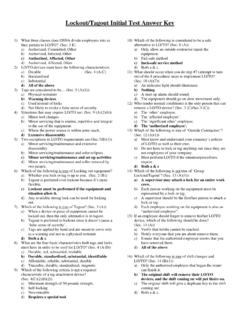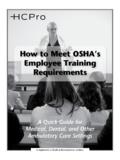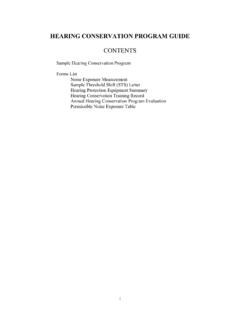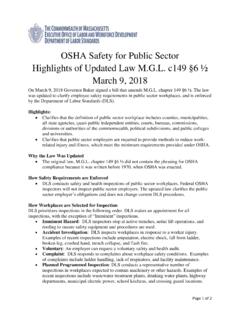Transcription of INSTRUCTOR’S TRAINING MANUAL - ACS - OSHA and EPA ...
1 LOCKOUT/TAGOUT instructor S TRAINING MANUAL 2 TABLE OF CONTENTS TRAINING Requirements Lockout/Tagout TRAINING Checklist TRAINING Sequence Class Introduction Lockout/Tagout Student Guide Section 1 Introduction 2 What is Lockout/Tagout? 3 What is Tagout? 4 Lockout/Tagout Devices Requirements 5 Key points about tags 6 When do we apply Lockout/Tagout? 7 Exceptions to LO/TO 8 Inch-Safe Service Method 9 When exceptions do not apply. 10 Eight procedural steps to implement Lockout/Tagout 11 Restoring normal operations 12 Outside Contractors 13 Group Lockout/Tagout 14 Special Procedures 15 Lockout/Tagout Assessment Form and Instructions Test Answer Key Sample Certificate 3 TRAINING The Regulations for TRAINING on Lockout/Tagout are found in CFR (c)(7)(i).
2 These regulations state: The employer shall provide TRAINING to ensure that the purpose and function of the energy control program are understood by employees and that the knowledge and skills required for the safe application, usage, and removal of the energy controls are acquired by employees. The TRAINING shall include the following: (A) Each authorized employee shall receive TRAINING in the recognition of applicable hazardous energy sources, the type and magnitude of the energy available in the workplace, and the methods and means necessary for energy isolation and control. AUTHORIZED: required at initial assignment and highly recommended on a yearly basis.
3 (B) Each affected employee shall be instructed in the purpose and use of the energy control procedure. AFFECTED: Required at initial assignment and again highly recommended that annual TRAINING be conducted. (C) All other employees whose work operations are or may be in an area where energy control procedures may be utilized, shall be instructed about the procedure, and about the prohibition relating to attempts to restart or reenergize machines or equipment which are locked out or tagged out. OTHER: Required at initial assignment and if possible to participate in annual TRAINING . The regulations only require one-time TRAINING however if through your annual review/audit you find employees demonstrate a lack of knowledge or failure to follow procedure then you might want to consider annual TRAINING as a means of performing good faith efforts at compliance.
4 RETRAINING will occur based on the following regulations: (iii) (A) Retraining shall be provided for all authorized and affected employees whenever there is a change in their job assignments, a change in machines, equipment or processes that present a new hazard, or when there is a change in the energy control procedures. (B) Additional retraining shall also be conducted whenever a periodic inspection under paragraph (c)(6) of this section reveals, or whenever the employer has reason to believe that there are deviations from or inadequacies in the employee s knowledge or use of the energy control procedures. (C) The retraining shall reestablish employee proficiency and introduce new or revised control methods and procedures, as necessary.
5 Furthermore the regulations state: (c)(7)(iv) The employer shall certify that employee TRAINING has been accomplished and is being kept up to date. The certification shall contain each employee s name and dates of TRAINING . 4 LOCKOUT/TAGOUT TRAINING CHECKLIST 1. Ensure all Authorized, Affected, Others are identified for TRAINING . 2. Identify anyone of the above employees who may have learning disabilities or may have difficulty with English, and make arrangements for their TRAINING . 3. Designate where TRAINING will take place and make sure everyone knows time/place. 4. Ensure you have enough TRAINING materials for all participants. You will need the following TRAINING materials: a.
6 Student Guides b. Tests/Answer Sheets c. TRAINING Certificates d. Sample Lockout/Tagout Locks and Tags e. Copies of written procedures specific to machines they may work on. f. Sample assessment forms if you want them to help compose new written procedures. g. Lockout/Tagout Video h. Ink pens for taking test and signing certificates. (not pencils!) i. Class sign-in sheet. 5 TRAINING Sequence 1. Review checklist to make sure everything is ready. 2. Have employees sign the Class Sign-In sheet. 3. Pass out TRAINING guides to employees. 4. Give them a brief introduction and cover sections 1-15. 5. Summarize key parts of TRAINING guides. 6. Following student guide instruction ask for any remaining questions.
7 7. Give out test and instructions. 8. Following the test, have employees trade tests and grade. Answer any questions. 9. Pass out TRAINING Certificates to be filled out and signed. 10. Collect tests and certificates. 11. Take employees out to production areas and review actual lockout/tagout procedures for their respective machines. 12. If time allows have them put locks and tags on their machine. 13. If you do not have written procedures then use the Assessment Form in the Student TRAINING Guide to have employees fill out and turn in. (Give them a due date!) 6 Class Introduction to LOCKOUT/TAGOUT Isolation of Hazardous Energy (LO/TO) Introduction My name Today we are going to talk about one of the most important safety programs as it relates to preventing serious accidents.
8 Cite statistics 120 deaths and 28,000 lost work hours occur because companies did not follow lockout/tagout procedures resulting in accidents. LO/TO Instruction You will be instructed on the key aspects of LO/TO. Topics we will cover are definitions of hazardous energy, when to apply LO/TO, how to apply LO/TO, Authorized employee, Affected employee, Other employee, etc. Test You may use your notes to take the A 25-question test will be administered. Following the test you will trade papers and I will review the answers. Also, this is your last opportunity in class for you to ask questions, especially for those questions on the test you may have answered incorrectly.
9 (You can of course ask questions later outside of class!) Certification Following the test you will fill out certifications and return along with the test. LO/TO Practical Exercise Following the class instruction, designated employees (especially the Authorized and Affected employees) will accompany me (the instructor ) out onto the plant floor in order to discuss real LO/TO applications. You will utilize the LO/TO assessment form, (located in the Student Guide) for the purpose of actually completing a Hazardous assessment and determining actual procedures for LO/TO on your respective pieces of equipment press, bindery equipment etc. 7 LOCKOUT/TAGOUT STUDENT GUIDE Section 1: Introduction (SG ) A.
10 Lockout/Tagout (LO/TO) procedures are a set of safety procedures that the Occupational Safety and Health Administration ( osha ) wants employees to follow in order to repair or maintain equipment in a safe manner. B. The importance of performing LO/TO is primarily to prevent accidents involving machinery. LO/TO accidents result in nearly 120 deaths a year because employees failed to perform proper LO/TO procedures. Many more injuries occur causing the loss of more than 28,000 work hours to companies. C. The purpose of LO/TO is to prevent the unexpected startup or release of energy, which could cause serious injury or death to someone working on a piece of equipment.





